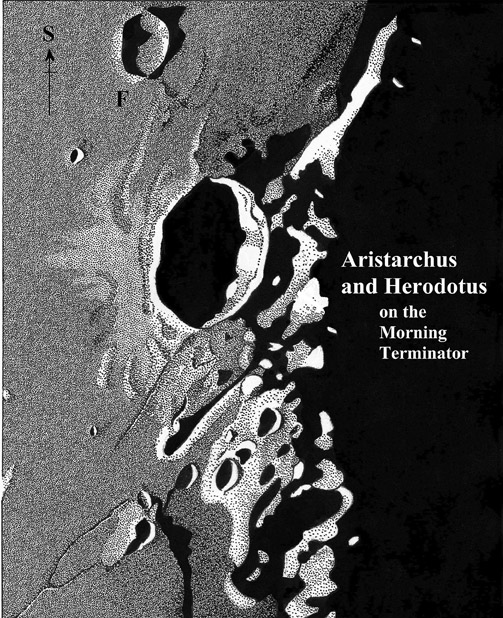May 30, 2019
Sunrise On Samos' Most Famous Astronomer
Originally published February 15, 2010
 image by Philip Morgan, UK |
At this early stage of illumination one of the most notable features is the exceptional brightness of the outer southeast rampart of Herodotus, equalling the intense brightness of the inner western glacis of Aristarchus itself. This is due to the fact that the outer southeast rampart of Herodotus is quite a steep scarp face and at this colongitude it catches the early morning solar rays almost’ head on’. A brightness no doubt enhanced by that fact that this scarp face has a dusting of the bright Aristarchus ray material over much of its surface. It is also at this stage of illumination that the famous dark radial banding that runs up the inner west glacis of Aristarchus is just becoming visible. These bands were once thought to be evidence for physical changes taking place on the lunar surface, since they were not recorded by the early lunar observers until they were described by Professor John Phillips in 1868. Although in fact they were shown clearly some five years earlier in a drawing made by Lord Rosse, using his great 72-inch reflector at Birr Castle. Since then there has been much discussion as to the true nature of these dusky bands, with a modern day interpretation being that they are due to dark ejecta emplaced at the time of the formation of Aristarchus, some 500 million years ago. This may indeed be so, but it is a theory that doesn’t account for the banding found on the outer slopes of some mountains, the most well known being Alhazen Alpha. It also fails to account for the fact, as shown on my drawing, that the bands are situated in shallow depressions, a fact noted in several other banded craters, unless somehow the ejected dark material was more abrasive. As the shadows recede down the inner rampart these band-filled depressions become more evident. Moving down/northwards from Aristarchus are several fine rilles, these being the Rimae Aristarchus. Just to the west of these is a prominent fault known as the Rupes Tuscanelli. This appears to be a dip-slip fault of similar nature to the Straight Wall, and is about 70 km in length, and was seen casting a prominent shadow to the lower ground to the west.
|
Yesterday's LPOD: Perambulation
Tomorrow's LPOD: Ghost Rim?
COMMENTS?
Register, Log in, and join in the comments.



